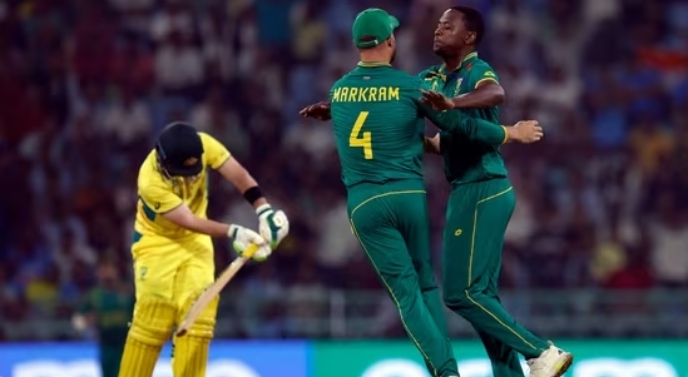
Australia’s performance in the 2023 Cricket World Cup has left fans and pundits scratching their heads, particularly when it comes to their batting. The team’s struggles began in their opening match against India, where they collectively managed to score only 199 runs in 49.3 overs before giving away all their wickets. Let’s explore the three key reasons behind Australia’s batting woes in the World Cup. But before exploring, let’s take a quick look at what happened to their batting in both of the games:
Match 1: Australia vs. India
Australia embarked on their World Cup campaign with high expectations, facing the formidable Indian team. However, their batting in this encounter left much to be desired. Chasing India’s score on batting-friendly pitches, they collectively managed a paltry 199 runs in 49.3 overs before succumbing to all their wickets.
The top-order, typically the strength of the Australian lineup, had a disappointing outing. Opener David Warner got them off to a promising start with 41 runs off 52 balls. But from there, things took a downturn. Steve Smith, known for his impeccable batting skills, seemed to be playing at a Test match tempo, scoring a sluggish 46 runs from 71 balls. This slow start put immense pressure on the rest of the batting order.
The middle-order, often regarded as the backbone of a cricket team, crumbled under pressure. Marnus Labuschagne contributed 27 runs from 41 balls, and Glenn Maxwell managed a mere 15 runs off 25 balls. To make matters worse, Alex Carey was dismissed for a duck in just two balls, and Alex Green’s 20-ball 8-run inning added little to the team’s score.
Thanks to the late-game heroics of Pat Cummins, who scored 15 runs, and Mitchell Starc’s 28 runs, Australia reached a somewhat competitive total of 199 runs. However, their batting performance was far from satisfactory, and it was evident that their lineup was struggling to adapt to the limited-overs format.
Despite their efforts, Australia’s strong batting lineup was unable to secure a victory. India managed to chase down the target with six wickets in hand, sparing 52 balls. This defeat was a significant blow to Australia’s World Cup aspirations.
Match 2: Australia vs. South Africa
In their second match, Australia faced South Africa, another cricketing powerhouse. While their bowling performance was commendable, Australia’s batting struggles persisted.
Chasing South Africa’s target of 311, Australia’s batsmen could only muster a meager 177 runs in 40.5 overs. The top order continued to underperform, with David Warner contributing just 14 runs, and Steve Smith adding 19 to the total. Marnus Labuschagne showed some resistance with 46 runs off 74 balls, but other middle-order batsmen, including Josh Inglis, Glenn Maxwell, and Marcus Stoinis, collapsed brutally.
Inconsistency in the playing XI further marred Australia’s performance. The constant shuffling of the lineup between the two matches disrupted team dynamics, making it difficult for players to settle into their roles and establish partnerships. The lack of a consistent team selection strategy hindered their ability to adapt to the competition effectively.
As the World Cup progresses, Australia faces a significant challenge. Their batting woes must be addressed to salvage their campaign. Finding a way to improve the top order’s strike rate, strengthen the middle order, and maintain a consistent playing XI will be critical if they hope to turn their fortunes around and make a mark in the remainder of the tournament.
3 problems with Australia’s batting
Lackluster Top Order
The Australian top order, considered one of the strongest in the world, failed to live up to its reputation in the 2023 World Cup. In their first match against India, opener David Warner provided a solid start with 41 runs off 52 balls. However, it was downhill from there. Steve Smith appeared to be playing a Test match, scoring 46 off 71 balls, which was far too slow for the limited-overs format. This sluggish start put pressure on the rest of the lineup.
Middle-Order Misfires
The middle-order is often considered the engine of a cricket team, responsible for building and maintaining momentum. Unfortunately, Australia’s middle-order in the World Cup struggled to do just that. Marnus Labuschagne managed to score 27 off 41 balls, and Glenn Maxwell contributed a meager 15 off 25 balls. Other middle-order batters like Josh Inglis, Marcus Stoinis, and Alex Carey had poor outings, resulting in a lack of substantial partnerships. The middle-order collapses have cost Australia crucial runs and matches.
Inconsistent Team Selection
One of the significant issues plaguing Australia’s World Cup campaign is the constant changes in the playing XI. In just two games, they shuffled the lineup, making it challenging for players to settle into their roles and form partnerships. Consistency in the playing XI is crucial in a tournament like the World Cup, and frequent changes can disrupt team dynamics. Perhaps sticking with the same XI in consecutive matches could have yielded better results.
Australia now faces Sri Lanka on October 16th, and it’s a critical match for them to turn their World Cup campaign around. If they hope to make an impact, addressing these three key issues – improving the top order’s strike rate, strengthening the middle order, and maintaining a consistent playing XI – will be essential for their success in the remainder of the tournament.
Also, see:
World Cup 2023: An extensive guide to Indo-Pak clash musical ceremony – What is a golden ticket?
